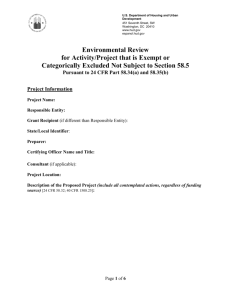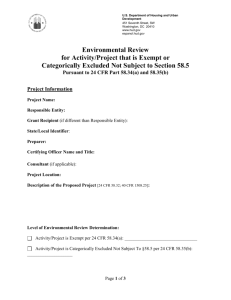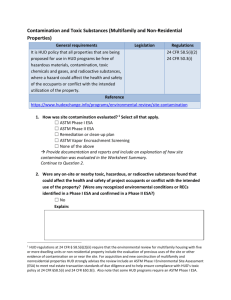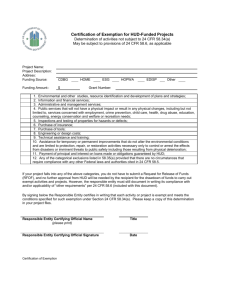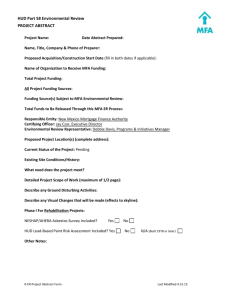INSTRUCTIONS for completing the STATUTORY WORKSHEET
advertisement
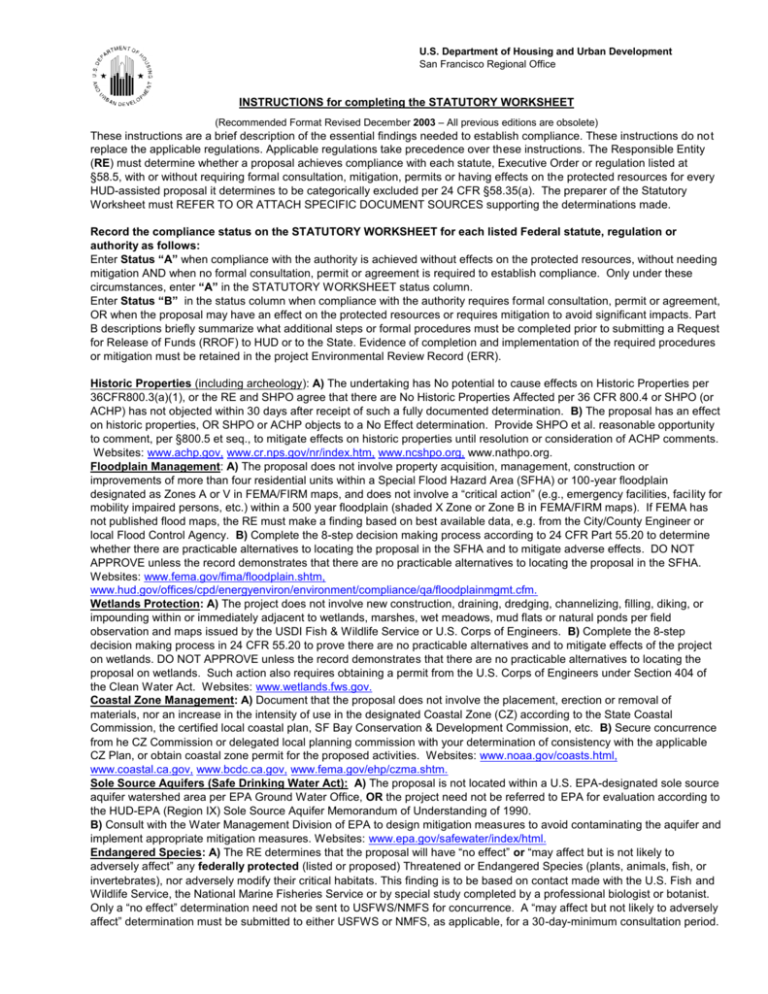
U.S. Department of Housing and Urban Development San Francisco Regional Office INSTRUCTIONS for completing the STATUTORY WORKSHEET (Recommended Format Revised December 2003 – All previous editions are obsolete) These instructions are a brief description of the essential findings needed to establish compliance. These instructions do not replace the applicable regulations. Applicable regulations take precedence over these instructions. The Responsible Entity (RE) must determine whether a proposal achieves compliance with each statute, Executive Order or regulation listed at §58.5, with or without requiring formal consultation, mitigation, permits or having effects on the protected resources for every HUD-assisted proposal it determines to be categorically excluded per 24 CFR §58.35(a). The preparer of the Statutory Worksheet must REFER TO OR ATTACH SPECIFIC DOCUMENT SOURCES supporting the determinations made. Record the compliance status on the STATUTORY WORKSHEET for each listed Federal statute, regulation or authority as follows: Enter Status “A” when compliance with the authority is achieved without effects on the protected resources, without needing mitigation AND when no formal consultation, permit or agreement is required to establish compliance. Only under these circumstances, enter “A” in the STATUTORY WORKSHEET status column. Enter Status “B” in the status column when compliance with the authority requires formal consultation, permit or agreement, OR when the proposal may have an effect on the protected resources or requires mitigation to avoid significant impacts. Part B descriptions briefly summarize what additional steps or formal procedures must be completed prior to submitting a Request for Release of Funds (RROF) to HUD or to the State. Evidence of completion and implementation of the required procedures or mitigation must be retained in the project Environmental Review Record (ERR). Historic Properties (including archeology): A) The undertaking has No potential to cause effects on Historic Properties per 36CFR800.3(a)(1), or the RE and SHPO agree that there are No Historic Properties Affected per 36 CFR 800.4 or SHPO (or ACHP) has not objected within 30 days after receipt of such a fully documented determination. B) The proposal has an effect on historic properties, OR SHPO or ACHP objects to a No Effect determination. Provide SHPO et al. reasonable opportunity to comment, per §800.5 et seq., to mitigate effects on historic properties until resolution or consideration of ACHP comments. Websites: www.achp.gov, www.cr.nps.gov/nr/index.htm, www.ncshpo.org, www.nathpo.org. Floodplain Management: A) The proposal does not involve property acquisition, management, construction or improvements of more than four residential units within a Special Flood Hazard Area (SFHA) or 100-year floodplain designated as Zones A or V in FEMA/FIRM maps, and does not involve a “critical action” (e.g., emergency facilities, facility for mobility impaired persons, etc.) within a 500 year floodplain (shaded X Zone or Zone B in FEMA/FIRM maps). If FEMA has not published flood maps, the RE must make a finding based on best available data, e.g. from the City/County Engineer or local Flood Control Agency. B) Complete the 8-step decision making process according to 24 CFR Part 55.20 to determine whether there are practicable alternatives to locating the proposal in the SFHA and to mitigate adverse effects. DO NOT APPROVE unless the record demonstrates that there are no practicable alternatives to locating the proposal in the SFHA. Websites: www.fema.gov/fima/floodplain.shtm, www.hud.gov/offices/cpd/energyenviron/environment/compliance/qa/floodplainmgmt.cfm. Wetlands Protection: A) The project does not involve new construction, draining, dredging, channelizing, filling, diking, or impounding within or immediately adjacent to wetlands, marshes, wet meadows, mud flats or natural ponds per field observation and maps issued by the USDI Fish & Wildlife Service or U.S. Corps of Engineers. B) Complete the 8-step decision making process in 24 CFR 55.20 to prove there are no practicable alternatives and to mitigate effects of the project on wetlands. DO NOT APPROVE unless the record demonstrates that there are no practicable alternatives to locating the proposal on wetlands. Such action also requires obtaining a permit from the U.S. Corps of Engineers under Section 404 of the Clean Water Act. Websites: www.wetlands.fws.gov. Coastal Zone Management: A) Document that the proposal does not involve the placement, erection or removal of materials, nor an increase in the intensity of use in the designated Coastal Zone (CZ) according to the State Coastal Commission, the certified local coastal plan, SF Bay Conservation & Development Commission, etc. B) Secure concurrence from he CZ Commission or delegated local planning commission with your determination of consistency with the applicable CZ Plan, or obtain coastal zone permit for the proposed activities. Websites: www.noaa.gov/coasts.html, www.coastal.ca.gov, www.bcdc.ca.gov, www.fema.gov/ehp/czma.shtm. Sole Source Aquifers (Safe Drinking Water Act): A) The proposal is not located within a U.S. EPA-designated sole source aquifer watershed area per EPA Ground Water Office, OR the project need not be referred to EPA for evaluation according to the HUD-EPA (Region IX) Sole Source Aquifer Memorandum of Understanding of 1990. B) Consult with the Water Management Division of EPA to design mitigation measures to avoid contaminating the aquifer and implement appropriate mitigation measures. Websites: www.epa.gov/safewater/index/html. Endangered Species: A) The RE determines that the proposal will have “no effect” or “may affect but is not likely to adversely affect” any federally protected (listed or proposed) Threatened or Endangered Species (plants, animals, fish, or invertebrates), nor adversely modify their critical habitats. This finding is to be based on contact made with the U.S. Fish and Wildlife Service, the National Marine Fisheries Service or by special study completed by a professional biologist or botanist. Only a “no effect” determination need not be sent to USFWS/NMFS for concurrence. A “may affect but not likely to adversely affect” determination must be submitted to either USFWS or NMFS, as applicable, for a 30-day-minimum consultation period. 2 C) Consult with the USFWS or with the National Marine Fisheries Service, in accordance with 50 CFR Part 402, to reduce or remove adverse effects on T&E species and their critical habitats. Formal consultation with USFWS or NMFS is required for all federally funded “major construction” activities and all activities “likely to adversely affect” T&E species. Websites: www.fws.gov, www.r1.fws.gov, http://ifw2irm2.irm1.r2.fws.gov/. Wild and Scenic Rivers: A) The project is not located within one mile of a listed Wild and Scenic River, OR the project will have no effects on the natural, free flowing or scenic qualities of a designated river in the National Wild and Scenic Rivers system. B) Consult with the U.S. Department of Interior, National Park Service for impact resolution and mitigation. Website: www.nps.gov/rivers/, www.hud.gov/offices/cpd/energyenviron/environment/compliance/qa/rivers.cfm. Air Quality: A) The proposal is located within an “attainment” area for “criteria pollutants”, OR, if within a “non-attainment” area, conforms with the EPA-approved State Implementation Plan (SIP), per contact with the Air Quality Management District or Board, AND the project requires no individual NESHAP permit or notification; B) Negotiate suitable mitigation measures with the Air Quality Management District or Board, obtain necessary permits, issue required notices. (For example, 40 CFR §61.145 requires 10-day prior notification to the Air Quality District Administrator whenever either 260 linear ft., 160 sq.ft., or 35 cubic ft., of asbestos containing material is to be disturbed). Website: www.epa.gov/oar/oaqps/greenbk/. Farmland Protection: A) The proposal site does not include prime or unique farmland, or other farmland of statewide or local importance as identified by the U.S. Department of Agriculture, Natural Resources Conservation Service NRCS (formerly the Soil Conservation Service, OR the project site includes prime or unique farmland, but is located in an area committed to urban uses; B) Request evaluation of land type from the NRCS using Form AD-1006, and consider the resulting rating in deciding whether to approve the proposal, as well as mitigation measures (including measures to prevent adverse effects on adjacent farmlands). Websites: www.nrcs.usda.gov/programs/fppa/, www.hud.gov/offices/cpd.energyenviron/environment/compliance/qa/farmlandprotection.cfm. Noise Abatement and Control: A) The proposal does not involve development of noise sensitive uses, OR the project is not within line-of-sight of a major or arterial roadway or railroad, OR ambient noise level is documented to be 65 LDN (CNEL) or less, based upon the HUD Noise Assessment Guidelines (NAG) for calculating noise levels and Airport Noise Contour maps; B) Apply the noise standard, per 24 CFR §51.101, to the decision whether to approve the proposal (see §51.104), and implement noise attenuation measures (NAG page 39-40) as applicable. Website: www.hud.gov/offices/cpd/energyenviron/environment/resources/guidebooks/noise/index.cfm. Explosive or Flammable Operations: A) The proposal is located at an Acceptable Separation Distance (ASD) from any above-ground explosive or flammable fuels or chemicals containers according to “Siting of HUD-Assisted Projects Near Hazardous Facilities” (Appendices F & G, pp. 51-52), OR the proposal will expose neither people nor buildings to such hazards based on field observations; B) reject the proposal or mitigate the blast overpressure and thermal radiation hazard with the construction of a barrier of adequate size and strength to protect the project and its occupants (per 24 CFR 51.205). Websites: www.hud.gov/offices/cpd/energyenviron/environment/resources/guidebooks/hazfacilities/index.cfm, www.hud.gov/offices/cpd/energyenviron/environment/compliance/qa/hazardindustry.cfm. Toxic Chemicals and Radioactive Materials: A) The subject and adjacent properties are free of hazardous materials, contamination, toxic chemicals, gasses and radioactive substances which could affect the health or safety of occupants or conflict with the intended use of the subject property. Particular attention must be given to nearby dumps, landfills, industrial sites and other operations with hazardous wastes or materials. B) Examine the pathways of exposure, assess the risk of exposure and mitigate the exposure to the toxic contamination accordingly by removing, stabilizing, shielding or encapsulating the toxic substances in accordance with the requirements of the appropriate Federal, state or local oversight agency; OR reject the proposal, particularly if it involves acquisition. (All property proposed for use in HUD programs must be free of hazardous materials, contamination, toxic chemicals and gases, and radioactive substances, where a hazard could affect the health and safety of occupants or conflict with the intended utilization of the property). See ASTM Standard E1527-00 for more guidance. Websites: www.rtk.net, www.epa.gov/enviro, www.epa.gov/superfund, www.scorecard.org, www.hud.gov/offices/cpd/energyenviron/environment/compliance/qa/toxic/cfm. Airport Clear Zones and Accident Potential Zones: A) The project is not within an FAA-designated civilian airport Runway Clear Zone (RCZ) -or Runway Protection Zone, or within a military airfield Clear Zone (CZ) or Accident Potential Zone (APZ) Approach Protection Zone, based upon information from the airport or military airfield administrator identifying the boundaries of such zones, OR the project involves only minor rehabilitation, OR the project involves only the sale or purchase of an existing property in the RCZ or CZ; B) Reject the proposal; It is HUD policy not to provide any development assistance, subsidy or insurance in RCZs or CZs unless the project will not be frequently used or occupied by people and the airport operator provides written assurances that there are no plans to purchase the project site. Website: www.hud.gov/offices/cpd/energyenviron/environment/compliance/qa/airport.cfm. Environmental Justice: A) The proposed site is suitable for its proposed use and will NOT be adversely impacted by adverse health or environmental conditions; B) Site suitability is a concern; the proposal is adversely affected by environmental conditions impacting low income or minority populations. Avoid such impacts or mitigate them to the extent practicable. Address and mitigate the disproportional human health or environmental effects adversely affecting the low income or minority populations OR reject the proposal. Website: www.hud.gov/offices/cpd/energyenviron/environment/compliance/qa/environmentaljustice.cfm, www.epa.gov/compliance/environmentaljustice/assessment.html; www.epa.gov/compliance/whereyoulive.html.


